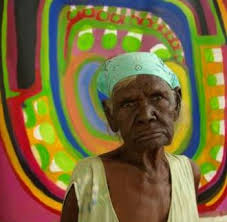
Indigenous Australian art includes art made by Aboriginal Australian and Torres Strait Islander peoples, including collaborations with others. It includes works in a wide range of media including painting on leaves, bark painting, wood carving, rock carving, watercolour painting, sculpting, ceremonial clothing and sand painting; art by Indigenous Australians that pre-dates European colonisation by thousands of years, up to the present day.

Torres Strait Islanders are the Indigenous Melanesian people of the Torres Strait Islands, which are part of the state of Queensland, Australia. Ethnically distinct from the Aboriginal people of the rest of Australia, they are often grouped with them as Indigenous Australians. Today there are many more Torres Strait Islander people living in mainland Australia than on the Islands.

The South Australian Museum is a natural history museum and research institution in Adelaide, South Australia, founded in 1856 and owned by the Government of South Australia. It occupies a complex of buildings on North Terrace in the cultural precinct of the Adelaide Parklands. Plans are under way to move much of its Australian Aboriginal cultural collection, into a new National Gallery for Aboriginal Art and Cultures.

The Adnyamathanha are a contemporary Aboriginal Australian people of the northern Flinders Ranges, South Australia, formed as an aggregate of several distinct peoples. Strictly speaking the ethnonym Adnyamathanha was an alternative name for the Wailpi, but the grouping also includes the Guyani, Jadliaura, Pilatapa and sometimes the Barngarla peoples. The origin of the name is in the words "adnya" ("rock") and "matha".
Kathleen Petyarre was an Australian Aboriginal artist. Her art refers directly to her country and her Dreamings. Petyarre's paintings have occasionally been compared to the works of American Abstract Expressionists Jackson Pollock and Mark Rothko, and even to those of J.M.W. Turner. She has won several awards and is considered one of the "most collectable artists in Australia". Her works are in great demand at auctions. Petyarre died on 24 November 2018, in Alice Springs, Australia.
Danie Mellor is an Australian artist who was the winner of 2009 National Aboriginal & Torres Strait Islander Art Award. Born in Mackay, Queensland, Mellor grew up in Scotland, Australia, and South Africa before undertaking tertiary studies at North Adelaide School of Art, the Australian National University (ANU) and Birmingham Institute of Art and Design. He then took up a post lecturing at Sydney College of the Arts. He works in different media including printmaking, drawing, painting, and sculpture. Considered a key figure in contemporary Indigenous Australian art, the dominant theme in Mellor's art is the relationship between Indigenous and non-Indigenous Australian cultures.
Doreen Reid Nakamarra was an Australian Aboriginal artist and painter. Reid was considered an important artist within the Western Desert cultural bloc. She was a leading painter at the Papunya Tula artist cooperative in Central Australia.
Wintjiya Napaltjarri, and also known as Wintjia Napaltjarri No. 1, is a Pintupi-speaking Indigenous artist from Australia's Western Desert region. She is the sister of artist Tjunkiya Napaltjarri; both were wives of Toba Tjakamarra, with whom Wintjiya had five children.
Lucy Napaljarri Kennedy is a Walpiri and Anmatyerre-speaking Indigenous artist from Australia's Western Desert region. One of the first Indigenous women artists to paint in acrylics, her work has been exhibited at major galleries around Australia, and is held in the collection of the National Gallery of Victoria. She was made a Member of the Order of Australia in 1994 for services to the Yuendumu community.
Linda Yunkata Syddick Napaltjarri is a Pintupi- and Pitjantjatjara- speaking Indigenous artist from Australia's Western Desert region. Her father was killed when she was young; her mother later married Shorty Lungkarta Tjungarrayi, an artist whose work was a significant influence on Linda Syddick's painting.
Jimmy Pike (c1940-2002) was a Walmatjarri Aboriginal artist.
Johnny Bulunbulun (1946-2010) was a Ganalbingu Aboriginal artist.
Nura Rupert is an Australian Aboriginal artist from north-west South Australia. She produces her works using intaglio methods of printmaking. The designs are drawn by etching and linocutting, and the prints are done on paper.
Milyika Carroll, also known as Alison Carroll, Alison Milyika Carroll, or "Windlass" Carroll, is an Aboriginal Australian artist. She is also a community leader on the Aṉangu Pitjantjatjara Yankunytjatjara Lands in South Australia.
Tiger Palpatja was an Australian Aboriginal artist from the Aṉangu Pitjantjatjara Yankunytjatjara Lands.

Jukuja Dolly Snell was an artist from Western Australia, who won the 2015 Telstra National Aboriginal and Torres Strait Islander Art Award.

Marrnyula Mununggurr (1964) is an Aboriginal Australian painter of the Djapu clan of the Yolngu people, known for her use of natural ochres on bark and hollow logs, wood carvings, linoleum and screen print productions.
The artist known as r e a is an Aboriginal Australian artist, also known as r e a Saunders, sometimes written Rea Saunders. As of 2019 r e a is a lecturer within the Aboriginal & Torres Strait Islander Unit at the University of Queensland.
Marie Elizabeth Rita McMahon is an Australian artist, known for her paintings, prints, posters, drawings, and design work. Born in Melbourne, she has worked in various communities of Australian Aboriginal people and as of 2020 works in Sydney. Her work has focused on social, political, and environmental issues. Her posters about Aboriginal rights and Aboriginal life appear in major gallery collections in Australia.
The Tin Sheds was the common name of the Sydney University Art Workshop was an Australian art workshop in Sydney, New South Wales, founded in 1969. Its name lives on in the Tin Sheds Gallery at the University of Sydney School of Architecture, Design and Planning. Groups such as Optronic Kinetics and the Earthworks Poster Collective operated out of Tin Sheds.






